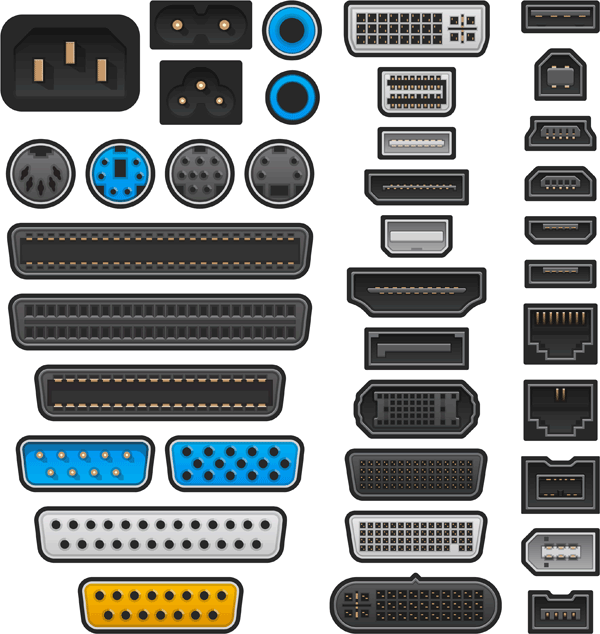computer ports
In Computer Networking, the term port can refer to either physical or virtual connection points. In computer terms, a port generally refers to the female part of connection. Computer ports have many uses, to connect a monitor, webcam, speakers, or other peripheral devices.
On the Physical Layer, a computer port is a specialized outlet on a piece of equipment to which a plug or cable connects. Electronically, the several conductors where the port and cable contacts connect provide a method to transfer signals between devices.
On the Transport Layer, a port is an application-specific or process-specific software construct serving as a communications endpoint in a computer's host operating system. The purpose of ports is to uniquely identify different applications or processes running on a single computer and thereby enable them to share a single physical connection to a packet-switched network like the Internet. In the context of the Internet Protocol, a port is associated with an IP address of the host, as well as the type of protocol used for communication.

Ports are two types:
Physical, 2. Virtual.
Ports on Physical Layer (Physical Port)
Physical ports are used for connecting a computer trough a cable and a socket to a peripheral device. Physical computer ports list includes serial ports (DB9 socket), USB ports (USB 2.0 or 3.0 socket / connector), parallel ports (DB25 socket/Connector) and Ethernet / internet ports (RJ45 socket / connector).
Physically identical connectors may be used for widely different standards, especially on older personal computer systems, or systems not generally designed according to the current Microsoft Windows compatibility guides. For example, a female 9-pin D-subminiature connector on the original IBM PC could have been used for monochrome video, color analog video (in two incompatible standards), a joystick interface, or for a MIDI musical instrument digital control interface. The original IBM PC also had two identical 5 pin DIN connectors, one used for the keyboard, the second for a cassette recorder interface; the two were not interchangeable. The smaller mini-DIN connector has been variously used for the keyboard and two different kinds of mouse; older Macintosh family computers used the mini- DIN for a serial port or for a keyboard connector with different standards than the IBM-descended systems.
Electronically, hardware ports can almost always be divided into two groups based on the signal transfer:
Serial ports send and receive one bit at a time via a single wire pair (Ground and +/-).Parallel ports send multiple bits at the same time over several sets of wires.
Types of Port
Digital Visual Interface,
Display Port,
E-SATA,
IEEE 1394 Interface (FireWire),
PS/2 Connector,
Serial Port,
USB,
VGA Connector
SCSI
HDMI,
Audio/Phone Connector
Few know Example:
20 & 21: File Transfer Protocol (FTP)
22: Secure Shell (SSH)
23: Telnet remote login service
25: Simple Mail Transfer Protocol (SMTP)
53: Domain Name System (DNS) service
80: Hypertext Transfer Protocol (HTTP) used in the World Wide Web
110: Post Office Protocol (POP3)
119: Network News Transfer Protocol (NNTP)
143: Internet Message Access Protocol (IMAP)
161: Simple Network Management Protocol (SNMP)
194: Internet Relay Chat (IRC)
443: HTTP Secure (HTTPS)
465: SMTP Secure (SMTPS)
for further detail follow me:
@zazaibot
Congratulations @zazaibot! You have completed some achievement on Steemit and have been rewarded with new badge(s) :
Click on any badge to view your own Board of Honor on SteemitBoard.
For more information about SteemitBoard, click here
If you no longer want to receive notifications, reply to this comment with the word
STOP